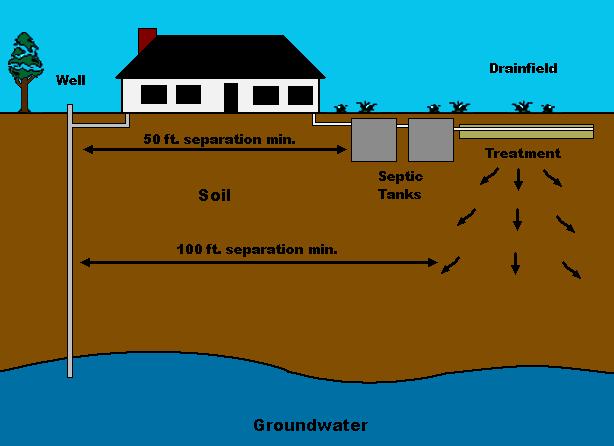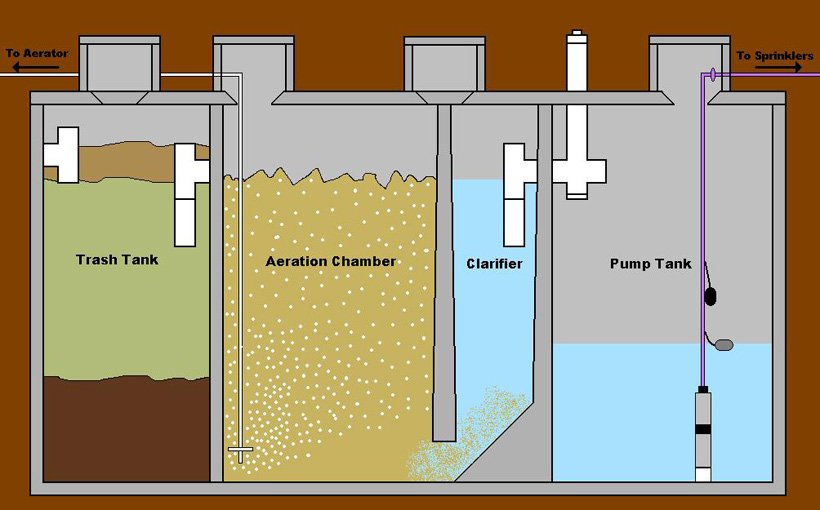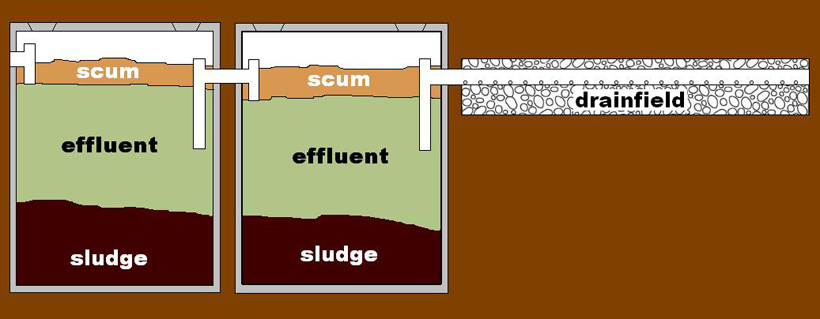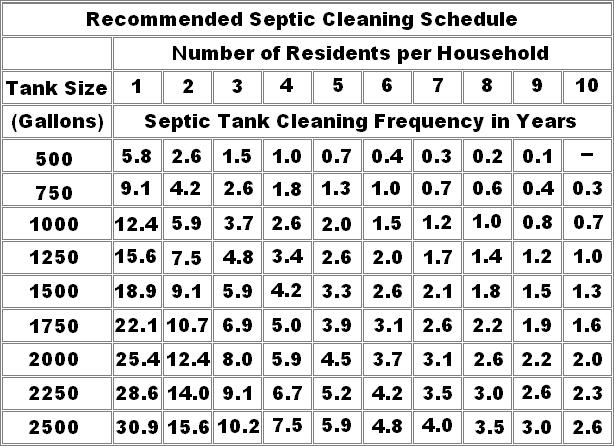Common Types of Septic Systems in Texas
CONVENTIONAL SEPTIC SYSTEM
The Tank:
The typical septic tank is a large buried cylindrical container made of concrete. A septic tank's purpose is to separate solids from the wastewater, store and partially decompose as much solid material as possible, while allowing the liquid (or effluent) to go to the drainfield.
Wastewater from your toilet, bath, kitchen, and laundry flows into the tank and remains there for up to 24 hours (known as the retention time) before it passes to the drainfield. This helps prevent clogging of the drainfield, which can lead to failure and costly repairs. Retention time is necessary to allow the solids to properly separate from the liquids—heavy solids settle to the bottom as sludge and the lighter particles rise to the top, forming a scum layer. Although bacterial action partially decomposes some of the solids, up to 50 percent remain in the tank.
As wastewater flows into the tank, a tee (or baffle) at the tank's inlet pipe slows the incoming wastes and reduces the disturbance of the settled sludge. The outlet tee keeps the solids or scum in the tank.
As the volume of sludge and scum builds up, there is less space and time for the solids to separate before the wastewater leaves the tank, which causes the system to be less effective. With not enough time for solids to settle, they can pass into the drainfield with the wastewater. This causes the drainfield to gradually plug and eventually fail, causing sewage to back up into the house or effluent to surface outside. Also, the closer the thickening scum and sludge layers come to the outlet tees, the greater the risk that they can plug the tank inlet or pass into the drainfield. The most common reason for system failure is not having the solids removed on a regular basis.
Consequently, it is important that solids be removed by periodic pumping, so they do not overflow into the drainfield. Most septic tanks need to be pumped every 2 to 3 years, depending on the tank size and the amount and type of solids entering the tank. (see chart below)
The Drainfield:
After solids settle in the septic tank, the liquid wastewater (or effluent) is discharged to the drainfield, also known as an absorption or leach field. The final treatment takes place in the soil below the drainfield.
The drainfield has a network of perforated pipes laid in gravel-filled trenches (2-3 feet wide) or beds (over 3 feet wide) in the soil. Wastewater trickles out of the pipes, through the gravel layer, and into the soil. The size and type of drainfield depends on the estimated daily wastewater flow and soil conditions.

The Soil:
The soil below the drainfield provides the final treatment and disposal of the septic tank effluent. After the wastewater has passed into the soil, chemical and biological processes treat the effluent before it percolates downward and outward, eventually entering the groundwater. These processes work best where the soil is somewhat dry, permeable, and contains plenty of oxygen for several feet below the drainfield.
AEROBIC SEPTIC SYSTEM

Aerobic Septic Trash Tank:
Waste from the house is fed into a "trash tank" (similar to a septic tank); septic solid waste and scum are retained in the trash tank and as with a conventional septic tank, must be periodically removed by a septic pumping company. (aerobic septic systems require more frequent septic tank pumping than a conventional septic system.)
The aerobic septic tank works like a septic tank but can be smaller because the system does not depend on a long settlement time to remove solids and grease as occurs in a conventional septic tank.
Aerobic Septic System Aeration Chamber & Aeration Pump:
An aerator or air pump, normally installed in a chamber atop or close to the septic tank, pumps air into the septic tank's aeration compartment using any of several methods to aerate the wastewater.
A mixing device or rotor may be used to further agitate the wastewater in the aerobic treatment tank to increase the oxygen level in the effluent and to support treatment by aerobic bacteria in the tank. Speaking slightly more technically, the aerobic process in the treatment tank provides for biochemical oxidation of the soluble organic compounds found in domestic wastewater.
Aerobic Septic Aeration Chamber:
Septic effluent moves out of the trash tank to a separate aeration chamber. In the aeration chamber air (oxygen) is pumped through the system to provide oxidation and waste treatment using a variety of designs. The added level of oxygen permits a variety of microbial life forms (bacteria, fungi, protozoa, and others) to oxidize or otherwise process pathogens and nitrogen compounds in the discharged septic effluent. The aerated, or oxygenated wastewater is called the "mixed liquor".
Aerobic Septic System Clarification Chamber:
After having been aerated and mixed in the aeration chamber, the effluent flows to a clarification chamber. Solids settle out of the effluent and flow back to the areation chamber. In some designs the sludge is recycled to the aeration chamber.
The settled sludge and solids support the formation of additional microbial growth which in turn is used to process pathogens as we just described. The aerobic system may, depending on its design, also remove nutrients, solids which were not retained in the trash tank, and pathogens.










